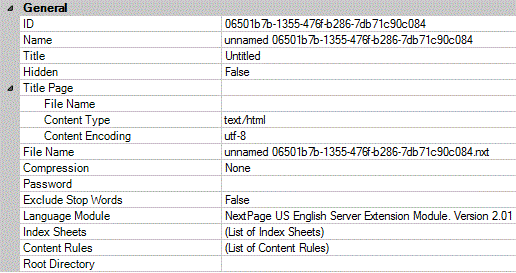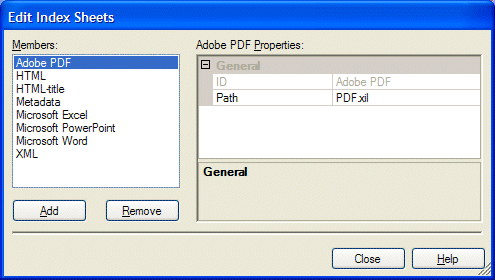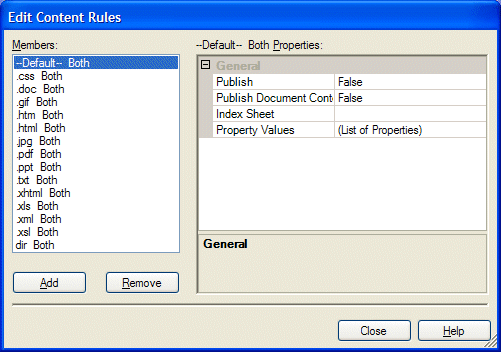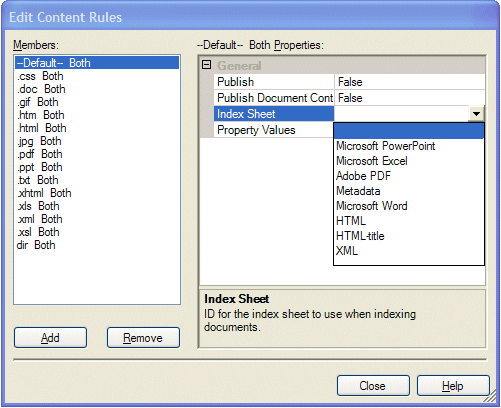
Content collection builder is a node in the library that enables you to define and build a content collection from within the Library Manager interface. In order to create a content collection, you must provide information for the Library Manager. The information that you provide is a list of properties necessary to build the content collection and update files from the source content. These properties exist in basically two groups: general properties of the content collection builder and specific properties of content bridge. Figure 1 shows the general properties of the content collection builder. The general properties are common to all NXT 4 content bridges and uniquely identify the content collection.

Figure 1. Collection Builder General Properties
Unique identifier for the content collection. The Library Manager generates a unique ID for every content collection or folder node in the Library. Create a unique ID if you need to change it. All IDs must be completely unique across the entire library and any site in which this library is installed, including content network links.
You cannot modify this property once the collection builder is saved and built. If you want to change this property after the collection is build, start the collection over.
Name is the property that defines the name of the content collection. The name must be unique among siblings
of this content collection builder in the library content hierarchy. NXT 4 uses
the name of the content collection when indicating paths for content and in the
URL on the NXT 4 site. Use the name value to create content links.
The initial default value is unnamed followed by the ID in
parenthesis.
Title is the property that defines what is displayed in the table of contents on a
NXT 4 site. This property does not have uniqueness criterion. The initial value
is Untitled.
File Name is the property that defines the name of the content collection file
that Library Manager saves in the output directory. The initial value of File Name
property equals the value of Name property. The .nxt
file extension at the end of the File Name property value is omitted.
Compression is the property that defines the level of compression to the content collection. There are three options for this property:
You cannot modify this property once the collection is saved and built. If you want to change this property after the building process is complete, start the collection over.
Password is the optional property that sets password for the content collection. If you set a password for the content collection, the NXT Builder system automatically encrypts that collection. You can implement license management only to the collections that are password protected.
You cannot modify this property once the collection is saved and built. If you want to change this property after the building process is complete, start the collection over.
Indicates whether to exclude stop words from the fast phrase index. Stop words are the words that generally do not add any value to a search. For example, the, it, is,a and other words. Excluding these words from the content collection reduces the size of the collection, because matches of these stop words are not included in phrase or proximity searches.
You cannot modify this property once the collection is saved and built. If you want to change this property after the building process is complete, start the collection over.
Language module is the property that identifies the language module for NXT. Language module is used for parsing and indexing of the documents for a collection.
You cannot modify this property once the collection is saved and built. If you want to change this property after the building process is complete, start the collection over.
Index sheets is the property that lists all the index sheets that give
instructions for NXT 4 on
how to index documents. Click the  button at the right of the property field to display the Edit Index Sheets
dialog that is shown on Figure 2.
button at the right of the property field to display the Edit Index Sheets
dialog that is shown on Figure 2.

Figure 2. Edit Index Sheets Dialog
The NXT 4 Builder comes with several index sheets for common content types like HTML
and XML that are stored in ...\Rocket\NXT 4\Builder\IndexSheets directory.
You can also
create index sheets with special indexing information.
Note: If changes are made to index sheets, start the collection over and redistribute the collection.
The Library Manager populates list of index sheets with the index sheet defaults. Table 3 shows the list of sheet defaults.
Table 3. Index sheet defaults
| ID | Path |
|---|---|
| Adobe PDF | PDF.xil |
| HTML | HTML.xil |
| HTML-title | HTML-title.xil |
| Metadata | Metadata.xil |
| Microsoft Excel | MSExcel.xil |
| Microsoft PowerPoint | MSPowerPoint.xil |
| Microsoft Word | MSWord.xil |
| XML | XML.xil |
| ODT | ODT.xil |
Each index sheet in the Edit Index Sheets dialog has the following two properties:
...\Rocket\NXT
4\Builder\IndexSheets directory.To index the content in the content collection, list all needed index sheets in the dialog box that is shown in the Figure 2.
Note: If you change settings in the index sheet files or modify the index sheet files after the content collection is built, the next time you build the content collection, the content bridge that builds the collection deletes and readds the affected documents to the content collection. This results in a larger update file. Before building the content collection or distributing the library to the end users, you must check that all the index sheets are correct.
Content Rules is the property that defines the list of rules according to which content is included into the content collection. Content rules define the index sheets that process and index each type of the document and define the values that certain properties have for these documents.
To display the Edit Content Rules dialog that is shown in the Figure 3, click the  button to the right of the Content Rules property field in the property window of content collection
builder.
button to the right of the Content Rules property field in the property window of content collection
builder.

Figure 3. Edit Content Rules Dialog
The NXT build system uses build rules to define how to create a document in the content collection from a source file. Each content bridge can set different defaults and handle different rules differently. See the Content Rules section of documentation for each respective content bridge for more content bridge-specific information. You can set the following three content rules that prompt the content bridge how to handle each document in the collection:
You can also set numerous property values for each document type that tell the content bridge what properties and values assign to each document of a given type.
The Publish rule determines whether the NXT build system includes a folder or
document node in the content collection. This is a boolean type rule with two values: True
or False. The Publish and Publish Document Content rules
operate together to create the content hierarchy and publish the content.
However, the Publish rule precedes Publish Document Content rule.
In other words, False value of Publish rule makes the Publish
Document Content rule setting disabled. Only True value of the Publish
rule makes the Publish Document Content rule applicable.
Note: Including a folder or document in a content collection means to publish that node.
The Publish document content rule determines whether the content
associated with a particular document is included in the content
collection. This rule is also a boolean type, True means that the content is published, False means that the content is not published. A document with False value in Publish Document Content is shown in the table of contents as a folder. The content bridge applies this rule only when the Publish rule is True.
When you select a document type in the Members list of the Edit Content Rules dialog, the Index Sheet rule identifies what index sheet to use for indexing the documents of corresponding document type. You can associate only one index sheet per document type. Figure 4 shows the Index Sheet property drop-down list that contains the index sheet values from the Index Sheet property of the content collection builder properties.

Figure 4. Index sheet values
A blank value indicates that the index sheet is not applied for indexing the content. A blank setting is appropriate for non-text based files: images, audio and video files and so on. NXT does not index non-text based files and other text-based documents like stylesheets. NXT performs a full-text index on all text based files whether you apply an index sheet or not.
Property Values is the property that presents a list of properties for a given document type. These properties and their values prompt NXT how to handle the documents that you build into the content collection. The File System Bridge supports the feature of assigning property values to the document types.
The Library Manager provides the functionality that you need for usage of any content bridge. The Library Manager enables you to set rules on a document-type level only. However, there may be instances where you may
need to create rules specific to branches of the library or specific documents
in the collection. You can customize additional content rules for the content bridges by manually modifying the Build
Configuration file that has .ccprops extension.
The .ccprops file is an XML file that conforms to the
BuildConfiguration.dtd. Therefore, to customize the publishing rules,
you must follow the rules in that Document Type Definition (DTD) file.
Note: Each collection builder node in the library has its own .ccprops file. This file is located in the Configurations folder of the library output directory. The Library Manager creates and initially populates this file the first time you select Save from the File menu and after you define a content builder. The Library Manager updates .ccprops files upon subsequent saves. The Library Manager uses the ID of the collection builder node with the .ccprops extension to name this file.
You can define a separate build rule for each document that you want to publish. However, it is likely that many of these rules are identical. For example, you may publish all file system folders in the same way and all text documents in the same way. The NXT build system allows you to aggregate source content together by using type, and, to publish source content of the same type in the same way.
Note: If you modify the .ccprops
for a collection while the collection library is open in Library Manager, you
see no changes until you close and reopen the library. If you make
changes in Library Manager before you reopen the library, all manual changes
are lost. Corresponding library must be closed when you manually
modify the .ccprops file.
Copyright © 2006-2023, Rocket Software, Inc. All rights reserved.